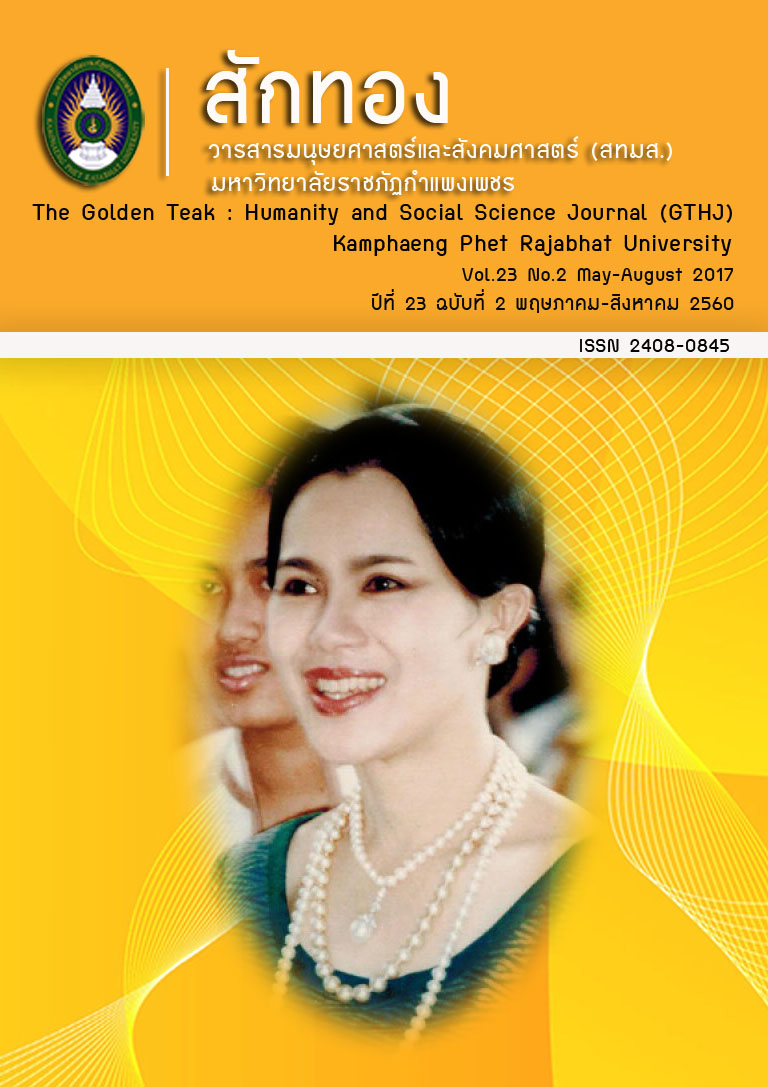จริยธรรมนักศึกษาและแนวทางพัฒนาจริยธรรมนักศึกษา
Main Article Content
Abstract
การวิจัยครั้งนี้ มีวัตถุประสงค์เพื่อ 1) ศึกษาตัวแบบจริยธรรมนักศึกษา (จริยธรรมสำหรับนักศึกษา) 2) ศึกษาจริยธรรมนักศึกษา และเปรียบเทียบจริยธรรมนักศึกษาตามความคิดเห็นของบุคคลทั่วไป จำแนกตามเพศ อายุ วุฒิการศึกษา สถานภาพ/อาชีพ และประสบการณ์ในตำแหน่ง/หน้าที่/อาชีพ และศึกษาจริยธรรม นักศึกษาและเปรียบเทียบ จริยธรรมนักศึกษา จำแนกตามเพศ อายุ ชั้นปีที่ศึกษา คณะที่สังกัด ค่าใช้จ่ายต่อเดือนระหว่างการศึกษา และอาชีพของผู้ปกครอง (นักศึกษา) 3) ศึกษาแนวทางพัฒนาจริยธรรมนักศึกษา และ4) ประเมินแนวทางพัฒนาจริยธรรมนักศึกษา การวิจัยครั้งนี้เป็นการวิจัยผสานวิธี คือ การศึกษาเชิงคุณภาพ และเชิงปริมาณ ผู้ให้ข้อมูล ได้แก่ ผู้บริหาร นักวิชาการ/ผู้เชี่ยวชาญ/ผู้ทรงคุณวุฒิ และผู้มีความรู้และประสบการณ์ทางด้านจริยธรรม ประชากรและกลุ่มตัวอย่าง ได้แก่ บุคคลทั่วไป นักศึกษา และผู้บริหาร นักวิชาการ/ผู้เชี่ยวชาญ/ผู้ทรงคุณวุฒิที่ผู้มีความรู้และประสบการณ์ทางด้านการศึกษา และการเรียนการสอนในระดับอุดมศึกษา เครื่องมือที่ใช้ในการวิจัย ได้แก่ แบบสัมภาษณ์ และแบบสอบถาม การวิเคราะห์ข้อมูล โดยการวิเคราะห์เนื้อหา การหาค่าความถี่ ค่าร้อยละ ค่าเฉลี่ย ส่วนเบี่ยงเบนมาตรฐาน การทดสอบค่าที (t-test independent) การวิเคราะห์ความแปรปรวน (F-test) และการเปรียบเทียบรายคู่ด้วยวิธีการของ Dunnett T3 ผลการวิจัย พบว่า ตัวแบบจริยธรรมนักศึกษา (จริยธรรมสำหรับนักศึกษา) 25 ประการ เช่น มีความรอบรู้ เฉลียวฉลาด เชี่ยวชาญในสาขาวิชาที่ตนศึกษา (ปัญญา) มีความขยันหมั่นเพียรในการศึกษาเล่าเรียน ไม่ย่อท้อ ไม่ทอดธุระ (วิริยะ) สนใจศึกษาเล่าเรียน อ่านตำรา ฟังคำบรรยายต่างๆ และสดับตรับฟังมาก (พาหุสัจจะ) เป็นต้น ความคิดเห็นของกลุ่มตัวอย่างต่อจริยธรรมนักศึกษา พบว่า นักศึกษามีจริยธรรมอยู่ในระดับมีปานกลาง (= 3.08 (บุคคลทั่วไป) และ= 3.24 (นักศึกษา)) การเปรียบเทียบจริยธรรมนักศึกษา จำแนกตามเพศ อายุ วุฒิการศึกษา สถานภาพ/อาชีพ และประสบการณ์ในตำแหน่ง/หน้าที่/อาชีพ (บุคคลทั่วไป) และเพศ อายุ ชั้นปีที่ศึกษา คณะที่สังกัด ค่าใช้จ่ายต่อเดือนระหว่างการศึกษา และอาชีพของผู้ปกครอง (นักศึกษา) พบว่า กลุ่มตัวอย่าง มีความคิดเห็นต่อจริยธรรมนักศึกษาไม่แตกต่างกัน และแตกต่างกันอย่างมีนัยสำคัญทางสถิติที่ระดับ .05 แนวทางพัฒนาจริยธรรมนักศึกษา 35 ประการ เช่น รัฐบาลกำหนดนโยบายการพัฒนาจริยธรรมนักศึกษาเป็นนโยบายสำคัญของรัฐ มหาวิทยาลัยกำหนดนโยบายพัฒนาจริยธรรมนักศึกษาเป็นนโยบายสำคัญ มหาวิทยาลัยมีแผนงานพัฒนาจริยธรรมนักศึกษาที่ชัดเจนและเป็นรูปธรรม เป็นต้น การประเมินแนวทางพัฒนาจริยธรรมนักศึกษา พบว่า ภาพรวมอยู่ในระดับเห็นด้วยมาก (= 4.14) โดยด้านมาตรฐานความเหมาะสม (= 4.19) ด้านมาตรฐานการใช้ประโยชน์ได้ (= 4.12) และ ด้านมาตรฐานความเป็นไปได้ (= 4.10)
The Student Ethics and the Guideline to Develop Student Ethics
ABSTRACT
The purposes of this research were, 1) to study student ethic models, 2) to study student ethics and compare student ethics classified by gender, age, education, occupation and experience (general public), and classified by gender, age, class level, department, monthly payment, and parent occupation (students), 3) to study the guidelines to develop student ethics, and 4) to assess the guidelines to develop student ethics. It is the mixed research. The respondents consisted of administrators, scholars, experts and people with experiences in ethics. Population and samplings composed general public, students, administrators, experts, scholars and people with experiences in ethics. The research instruments were an interview form and a questionnaire. The data were analyzed using frequency, percentage, mean, standard deviation, t-test independent, F-test and Dunnett T3 pairwise comparison test. The finding revealed that the student ethic models consisted of 25 items such as having wisdom and intelligence in a subject matter (Paññã), being diligent in studying (Viriya), studying hard and hearing more (Bãhusucca) etc. The opinions of the samples towards the student ethics revealed that the student ethics, as a whole, were at an average level (= 3.08 (general public) and = 3.24 (students)). The comparative results of student ethics classified by gender, age, education, occupation and experiences (general public), and classified by gender, age, class level, department, monthly payment, and parent occupation (students) revealed that their opinions towards student ethics were not different, and also significantly different at .05 level. The guidelines to develop student ethics consisted of 35 items. For example, 1) the government should set the student ethics development policy as the main policy, 2) the university should impose student ethics development policy as the main policy, and 3) the university should have a clear and concrete plan to develop student ethics etc. The assessment results of the guidelines to develop student ethics, as a whole, were at a high level (= 4.14), while the measure of suitability standard was at the high level (= 4.19), the measure of utility standard was at the high level (= 4.12), and the measure of feasibility standard was at the high level (= 4.10)
Article Details
บทความที่ได้รับการตีพิมพ์เป็นลิขสิทธิ์ของวารสาร สักทอง : วารสารมนุษยศาสตร์และสังคมศาสตร์ สถาบันวิจัยและพัฒนา มหาวิทยาลับราชภัฏกำแพงเพชร
ข้อคิดเห็นใดๆ ที่ปรากฎในวารสารเป็นวรรณกรรมของผู้เขียนโดยเฉพาะ ซึ่งมหาวิทยาลัยราชภัฏกำแพงเพชรและบรรณาธิการไม่จำเป็นต้องเห็นด้วย


